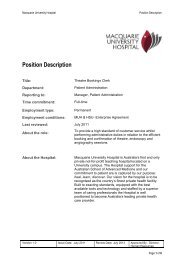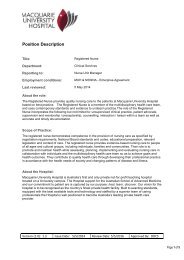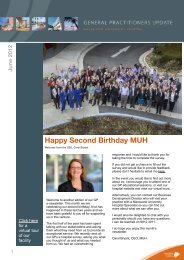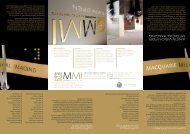Plenary Oral Presentations - Macquarie University Hospital
Plenary Oral Presentations - Macquarie University Hospital
Plenary Oral Presentations - Macquarie University Hospital
You also want an ePaper? Increase the reach of your titles
YUMPU automatically turns print PDFs into web optimized ePapers that Google loves.
16 th International Meeting of the Leksell Gamma Knife ® SocietyMarch 2012, Sydney, AustraliaPH-160A simple proposal to reduce cervical target movementduring Leksell Perfexion® Gamma Knife radiosurgeryL Dade Lunsford, Daniel Tonetti, Jagdish Bhatnagar<strong>University</strong> of PittsburghObjective: The design of the Leksell Perfexion ® (PFX) Gamma Knife facilitates inferior target stereotacticradiosurgery (SRS) providing that the target itself is above the standard G-frame base ring.Concern has been raised about the potential of target movement in the region from the occiput to C4.This study documents the potential target deviation using the current Leksell frame.Methods: A commercially available skull and cervical spine model was adapted for SRS using theLeksell PFX Gamma Knife. Both CT and fluoroscopic imaging were performed to determine thepotential for target deviations at standard Gamma Knife angles of 70, 90, and 110 degrees. In addition,target deviation at various heights of the patient positioning table was compared to a standard90 degree angle.Results: Multiple radio-opaque targets embedded in the model showed target deviations which rangedfrom as low as 0.58mm at the medial C1-occiput junction to 13.32mm at C3-4 during 70° extension.Target deviation relative to a 90° CT scan at 110° flexion showed deviations that ranged from2.79mm at the C1-occiput junction to 17.53mm for the medial target at the C3-4 junction.Relative to a PFX shoulder table height of 4.5cm, target deviation at a height of 3cm varied from0.436mm to 5.255mm. For a height at 5.5cm, target deviation varied from 0.436mm to 3.598mm.For a height at a maximum of 5.8cm, target deviation varied from 0.617mm to 4.298mm.Using the standard G frame, placed as inferiorly on the head as possible using ear bar extenders, wecan reliably image to C4 using MRI and CT co-registration. A commercially available cervico-thoracicMRI compatible brace placed before frame application will significantly reduce target deviationrelated to imaging and treatment portions of SRS procedures.Conclusions: As expected, target deviation grossly exceeds clinical tolerance and was determined to begreater the further the distance from the occiput to the cervical spine target. Simple and reproduciblemethods that allow centers to treat inferior targets reliably without the need for reengineering thecurrently widely available G frame may increase the range of targets that can be treated effectivelyusing the current model of the LGK PFX.59
















